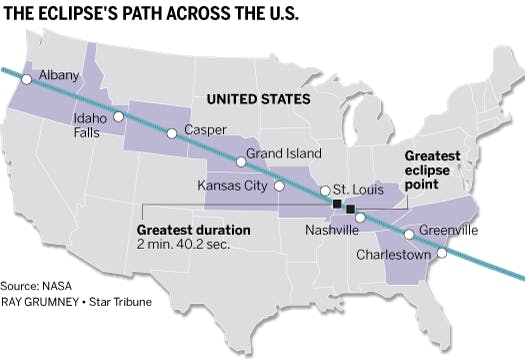The weather is looking iffy for Minnesotans staying home Monday hoping to get a glimpse of what's being dubbed "The Great American Solar Eclipse." Traffic might not be a joy, either, for those making a road trip.
More than 200 million Americans live within a day's drive of one of the 14 states where the moon will momentarily totally block out the sun. So highways and byways are expected to be gridlocked, even in largely rural areas of Wyoming and Nebraska where there has never been a traffic jam, said Doug Hecox, a spokesman for the Federal Highway Administration.
For months, federal and state transportation officials from affected states have been preparing for the first coast-to-coast total solar eclipse in the United States in 99 years and the crowds it is expected to attract.
This week they have been peppering social media with safety messages reminding drivers to turn on their headlights manually and to watch out for pedestrians, bicyclists and motorists who stop to take in the midday cosmic sight.
With the coast-to-coast spectacle set to cross 29 freeways on its 2,800-mile-long path from Oregon to South Carolina, the highway administration is posting messages on electronic signs that read, "A total solar eclipse is coming. The sky will get dark. The sun will appear to go away in the middle of the day. Do not slam on your brakes. Do not be afraid."
The agency is concerned that the eclipse could become a "monumental distraction," Hecox said. What if drivers try to take eclipse selfies from behind the wheel?
Another word of warning: "Don't wear eclipse viewing glasses while driving," he said, noting that they are too dark to see through.
Woodrow Wilson was in the White House and there were only 6.2 million vehicles in the country during the most recent great transcontinental total solar eclipse, in 1918. "Now we have 263 million vehicles. With a greater volume there is a greater risk of a crash," Hecox said. "We worry about texting and driving, but not everybody has a smartphone. This is something bigger. Everybody has a sun."
The most recent total eclipse viewable somewhere in the continental United States occurred on Feb. 26, 1979, and the next one won't occur until 2024. That's another reason there's such a big interest in what Hecox calls "a once-in-a-lifetime" event.
Ill-timed Minnesota front
Here in Minnesota, the celestial phenomenon will obscure 80 percent of the sun. But that's if we can see it.
An ill-timed front dropping into Minnesota Sunday night into Monday morning has the potential to bring clouds and storms to the area and block out the eclipse, which will peak locally at 1:06 p.m.
"It's iffy," said meteorologist Mike Griesinger of the National Weather Service's Chanhassen office. "If we get thunderstorms Sunday night then we have a shot. If that gets pushed out into Monday, then our chances are limited. We are in a holding pattern."
For a sure bet, several places will hold eclipse viewing parties, including Afton State Park, the Dodge Nature Center in West St. Paul, the Three Rivers Park District's Silverwood Park in St. Anthony, the Science Museum of Minnesota, Lebanon Hills Regional Park in Eagan and many local libraries.
Tim Harlow • 612-673-7768

Minnesota State Patrol celebrates diverse new class of troopers

Fired Mpls. teacher accuses management of 'cancerous rot'

Jill Biden rallies women, teachers for the Biden-Harris ticket in Bloomington speeches
Neighbors, city officials at odds over Rochester lake dam



